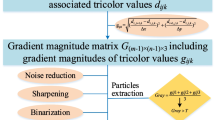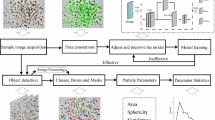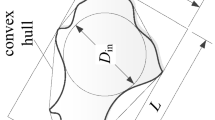Abstract
The structural properties of the dust layer, including its thickness, porosity, and particle size distribution, play a critical role in ensuring the high precision and long-term stability of filter elements. However, observing these properties is challenging due to the weak adherence and cohesiveness of the layer. To address this issue, atomization thermosetting glue was used to achieve pre-curing, and the entire dust layer was cured with epoxy resin. After the sample was frozen and fractured using liquid nitrogen, the boundaries of the dust particles became plainly visible. Traditional binarization techniques were insufficient in identifying the edges of the dust particles since the grayscale values of particles and their environment partially overlap. As a result, a deep learning model based on the DeeplabV3+ network architecture was used to identify particles in the dust layer and achieved an accuracy of 90.99%. The research reveals that pulse-jet cleaning can double the thickness of the local dust layer on adjacent filter elements. Additionally, the surface morphology of the filter element significantly impacts the shape and thickness of the dust layer, causing it to change dramatically. Uneven thickness of the dust layer can result in a higher number of dust particles passing through the filter element membrane.
Similar content being viewed by others
References
J. C. Lin, T. Hsiao, S. Hsiau, D. Chen, Y. Chen, S. Huang, C. Chen and M. Chang, Sep. Purif. Technol., 198, 146 (2018).
S. Berbner and T. Pilz, Powder Technol., 86, 103 (1996).
D. Koch, J. Seville and R. Clift, Powder Technol., 86, 21 (1996).
R. Boudhan, A. Joubert, S. Durécu, K. Gueraoui and L. Le Coq, J. Aerosol Sci., 130, 1 (2019).
L. F. Liu, Korean J. Chem. Eng., 38, 2122 (2021).
M. Lupion, B. Navarrete, B. Alonso-Farinas and M. Rodriguez-Galan, Fuel, 108, 24 (2013).
K. Furumoto, T. Fukasawa, T. Ishigami, M. Irwan Fatkhur Rozy, H.-P. Kuo, A.-N. Huang and K. Fukui, Adv. Powder Technol., 33, 103602 (2022).
J. H. Kim, Y. C. Kim and J. H. Choi, Korean J. Chem. Eng., 33, 726 (2016).
A. C. B. Neiva and L. Goldstein, Chem. Eng. Process., 42, 495 (2003).
J. H. Choi, S. J. Ha, Y. C. Bak and Y. O. Park, Korean J. Chem. Eng., 19, 1085 (2002).
D. Q. Jiang, W. D. Zhang, J. T. Liu, W. Geng and Z. Q. Ren, Korean J. Chem. Eng., 25, 744 (2008).
D. P. i. M. M. D. M. Kanaoka, T. Kishima and M. Furuuchi, High Temperature Gas Cleaning (1996).
C. R. N. Silva, V. S. Negrini, M. L. Aguiar and J. R. Coury, Powder Technol., 101, 165 (1999).
W. Höflinger, C. Stöcklmayer and A. Hackl, Filtr. Sep., 31, 807 (1994).
M. L. Aguiar and J. R. Coury, Ind. Eng. Chem. Res., 35, 3673 (1996).
J. H. Kim, Y. Liang, K. M. Sakong, J. H. Choi and Y. C. Bak, Powder Technol., 181, 67 (2008).
M. Hata, M. Furuuchi, C. Kanaoka, R. Kurose and H. Makino, Adv. Powder Technol., 14, 719 (2003).
A. Y. Al-Otoom, Y. Ninomiya, B. Moghtaderi and T. F. Wall, Energy Fuels, 17, 316 (2003).
N. Döring, J. Meyer and G. Kasper, Chem. Eng. Sci., 64, 2483 (2009).
I. Tomasetta, D. Barletta and M. Poletto, Adv. Powder Technol., 24, 609 (2013).
L. G. Tong, X. D. Chen, Y. P. Zhang, S. W. Yin, C. P. Liu, L. Wang and Y. L. Ding, Powder Technol., 354, 760 (2019).
C. Kanaoka, M. Hata and H. Makino, Powder Technol., 118, 107 (2001).
H. Chi, Z. Ji and B. Du, J. China Univ. Pet., Ed. Nat. Sci., 35 (2011).
P. C. Zhao and Y. G. Li, Colloid Surf. A-Physicochem. Eng. Asp., 585 (2020).
S. Suresh and S. Lal, Appl. Soft Comput., 55, 503 (2017).
B. Li, W. Zhang, Y. Xue, R. Kong, W. Zhu, Y. Yu and Y. Chen, Int. J. Rock Mech. Min. Sci., 158, 105195 (2022).
L. Deng and D. Yu, Found. Trends Signal Process., 7, 197 (2014).
E. Shelhamer, J. Long and T. Darrell, IEEE Trans. Pattern Anal. Mach. Intell., 39, 640 (2017).
J. Stallkamp, M. Schlipsing, J. Salmen and C. Igel, Neural Networks, 32, 323 (2012).
Y. Niu, P. Mostaghimi, M. Shabaninejad, P. Swietojanski and R. T. Armstrong, Water Resour. Res., 56 (2020).
S. Karimpouli and P. Tahmasebi, Comput. Geosci., 126, 142 (2019).
P. I. Guntoro, G. Tiu, Y. Ghorbani, C. Lund and J. Rosenkranz, Miner. Eng., 142, 105882 (2019).
T. I. Anderson, B. Vega and A. R. Kovscek, Comput. Geosci., 145, 104593 (2020).
M. P. Filippo, O. da Fonseca Martins Gomes, G. A. O. P. da Costa and G. L. A. Mota, Miner. Eng., 170, 107007 (2021).
Y. Wang, X. Bai, L. Wu, Y. Zhang and S. Qu, Fuel, 308, 121844 (2022).
T. A. Sipkens and S. N. Rogak, J. Aerosol Sci., 152, 105699 (2021).
H. Chi, Z. Ji and D. Sun, J. China Univ. Pet., Ed. Nat. Sci., 23, 72 (2010).
X. Tian and D. Hugh, The Leading Edge, 37, 435 (2018).
L.-C. Chen, G. Papandreou, F. Schroff and H. Adam, Rethinking atrous convolution for semantic image segmentation, arXiv (2017).
E. Schmidt and F. Löffler, Powder Technol., 60, 173 (1990).
W.-M. Lu and K.-J. Hwang, AIChE J., 41, 143 (1995).
J. H. Choi, S. J. Ha and H. J. Jang, Powder Technol., 140, 106 (2004).
K. J. Jeon and Y. W. Jung, Powder Technol., 141, 1 (2004).
Z. Ji, S. Peng, H. Chen and M. Shi, CIESC J., 35 (2003).
S. Peng, Z. Ji and H. Chen, J. Combust. Sci. Technol., 498 (2002).
M. Saleem, G. Krammer and M. S. Tahir, Powder Technol., 228, 100 (2012).
M. Koch and G. Krammer, Powder Technol., 292, 149 (2016).
Acknowledgements
The National Key Research and Development Program of China (2021YFB3801304) and the National Natural Science Foundation of China (No. 51904315) supported this work. The authors are also grateful to Prof. Haixia Li at Henan Polytechnic University for her suggestions and discussions.
Author information
Authors and Affiliations
Corresponding author
Ethics declarations
The authors declare that they have no known competing financial interests or personal relationships that could have appeared to influence the work reported in this paper.
Rights and permissions
About this article
Cite this article
Li, B., Ji, Z., Mu, J. et al. Experimental study of cured dust layer structure parameters based on semantic segmentation. Korean J. Chem. Eng. 40, 2271–2281 (2023). https://doi.org/10.1007/s11814-023-1414-2
Received:
Revised:
Accepted:
Published:
Issue Date:
DOI: https://doi.org/10.1007/s11814-023-1414-2




